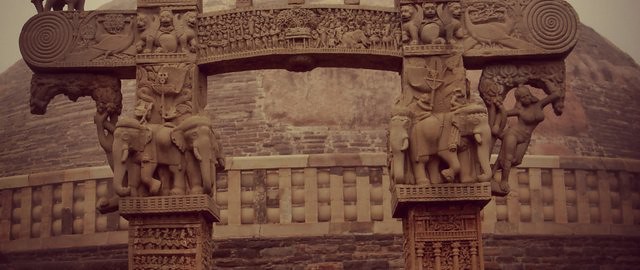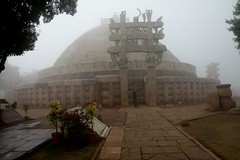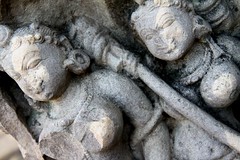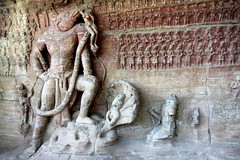
Sanchi
Today morning we woke up late, had a leisurely breakfast and then stepped out to visit Sanchi’s World Heritage site – the Stupas. Again, the air was completely engulfed in fog and it was quite cold. We were  glad that, as intended earlier, we didn’t try to wake up early to see dawn at the Stupas (recommended by the guidebooks) – no Sun or monument could have been seen through this fog for sure.
glad that, as intended earlier, we didn’t try to wake up early to see dawn at the Stupas (recommended by the guidebooks) – no Sun or monument could have been seen through this fog for sure.
The Stupas are built atop a rounded hill, which was selected by Emperor Asoka for its peace and serenity. The ticket counter was at the base of the hill and then it was about a kilometer uphill; not very strenuous. In fact, in this weather, the walk was very pleasant – Madhu and I really enjoyed it. At the entrance to the site, we had to pass thru a metal detector and our bags were checked. For a change, the security guard, a lady, was very thorough with her job – she checked both our bags minutely. We were quite impressed with her.
Just as expected, Sanchi’s Stupas are very well maintained and enclosed in a beautifully landscaped area. When we entered the site, it was quite foggy and gave the place a lovely, eerie feel. As the outline of  the main Stupa, Stupa 1, came up before us, it literally took our breath away! The Stupa was originally built in brick by Asoka in 3rd century B.C – about 2500 years ago! But later it was enlarged by building a stone one around it. Encircling the Stupa is a stone wall that has four entrances. Each entrance has a beautiful Torana (decorative entrance gateway). The Torana at the entrance facing us was absolutely gorgeous! We had never seen anything like this! It was completely covered in fine carvings depicting the various lives of Buddha (also known as Jatakas). They are supposed to be the finest Buddhist works of art in Sanchi, if not India.
the main Stupa, Stupa 1, came up before us, it literally took our breath away! The Stupa was originally built in brick by Asoka in 3rd century B.C – about 2500 years ago! But later it was enlarged by building a stone one around it. Encircling the Stupa is a stone wall that has four entrances. Each entrance has a beautiful Torana (decorative entrance gateway). The Torana at the entrance facing us was absolutely gorgeous! We had never seen anything like this! It was completely covered in fine carvings depicting the various lives of Buddha (also known as Jatakas). They are supposed to be the finest Buddhist works of art in Sanchi, if not India.
We entered the Stupa through the northern gateway. It had elephants supporting the arches above the columns and a broken wheel at the very top. From here we did a Parikrama of the Stupa by walking around it  clock-wise. The Torana at the southern entrance had back-to-back lions supporting the arches – this is the Asoka emblem of India and it was absolutely fantastic to see the origin of it! Stone steps led up to a stone platform built halfway up the Stupa, encircling it completely. We walked up to the platform, walked around the Stupa and enjoyed gazing at all the Toranas again.
clock-wise. The Torana at the southern entrance had back-to-back lions supporting the arches – this is the Asoka emblem of India and it was absolutely fantastic to see the origin of it! Stone steps led up to a stone platform built halfway up the Stupa, encircling it completely. We walked up to the platform, walked around the Stupa and enjoyed gazing at all the Toranas again.
We exited the stupa from the western gateway and found steps leading down to a large, dry tank and ruins of a monastery. The monastery had a rectangular courtyard in the center with living quarters, quite like stone cubicles, built around it. From the monastery more stone steps led down to Stupa 2. Unlike Stupa 1, this was a very simple one with no Torana at the entrance. But it was still quite elegant to look at. Walking back up to Stupa 1, we turned right and found ruins of quite a few temples and monasteries, built between the 8th and 11th century. The temples had Greek-like columns supporting simple prayer rooms. Two of the temples above the monasteries, had wonderful stone images of Buddha.
Walking back downhill we visited Stupa 3, which was similar to Stupa 2 in style but had a beautiful Torana at its southern entrance. There were 2 other stupas as well but these were without any adornments. We later learnt that more excavation is underway and many new structures are still being found – amazing!
By the time we headed back down the hill, it was about 12pm – we had spent about 2.5 hours visiting the Stupas. At the base of the hill, behind the ticket counter is a small museum maintained by the Archaeological Society of India. We were able to visit it with the same ticket that we bought for the Stupas. Inside, there were many artifacts and sculptures found during the excavation of the hill. The highlight, though, was the mammoth 3rd century BC sculpture of back-to-back lions, India’s emblem. This sculpture, originally, sat atop a stone pillar erected by Asoka within the Stupa enclosure. But it was broken by a local, ignorant zamindar so the sculpture was brought to the museum.
Walking back towards our hotel, we realized that, since it was just about1pm, we could visit Udayigiri today as well. The guidebooks had mentioned that it was less than 20km from Sanchi and had caves with rock-cut sculptures. So we hired an auto (Rs.200 return fare) and set out towards Udayigiri. The scenery en route was so beautiful that I thought that it was worth paying Rs.200 just to drive by this place. The narrow village road cut through acres and acres of green fields with a few trees spread in between – it was unbelievably gorgeous – India at its best!
Udaygiri caves are cut into the Udayigiri hill, which is so called because the hill (Gir)  faces east from where the early morning sun’s (Uday) rays fall on it. The caves, about 20 of them, are dated to be from 4th century AD, during the reign of Chandragupta II. Today they are fenced off from the road and a caretaker has been posted to keep an eye on things. When we got there, we were the only visitors. The caretaker acted as our guide and showed us around. We first visited caves 5 & 6. Cave 5 has the finest carving ever – a large 12ft sculpture of Lord Vishnu in the Varaha (boar) avatar. The idol showed Mother Earth being rescued by the boar with the ocean at its feet, with tiny figures of deities paying their obeisance – this has got to be my most favorite sculpture till date! Cave 6 had a small Shiva Lingam, which was square instead of the usual rounded image. Many sculptures on the outer walls were demolished by marauding Mughal invaders.
faces east from where the early morning sun’s (Uday) rays fall on it. The caves, about 20 of them, are dated to be from 4th century AD, during the reign of Chandragupta II. Today they are fenced off from the road and a caretaker has been posted to keep an eye on things. When we got there, we were the only visitors. The caretaker acted as our guide and showed us around. We first visited caves 5 & 6. Cave 5 has the finest carving ever – a large 12ft sculpture of Lord Vishnu in the Varaha (boar) avatar. The idol showed Mother Earth being rescued by the boar with the ocean at its feet, with tiny figures of deities paying their obeisance – this has got to be my most favorite sculpture till date! Cave 6 had a small Shiva Lingam, which was square instead of the usual rounded image. Many sculptures on the outer walls were demolished by marauding Mughal invaders.
Most of the entrances to the other caves have been closed with a mesh gate but the caretaker opened the important ones for us to view. Cave 4 had one of the best Shiva Lingams we’ve ever seen  – it had Lord Shiva’s face sculpted on to the Lingam, complete with his third eye – the most unique thing we’d ever seen! The caretaker informed us that all these sculptures were cut into the caves by hand – none of them were placed there! Another cave had a beautiful, muscular-looking image of Karthikeya, Lord Ganesha’s brother. Karthikeya is highly revered in south India and I had hardly found any references to him in the north. Later we were led to a large sculpture, which showed Lord Vishnu in the Anandashayanam pose. This was a fabulous piece of art as well but we couldn’t have a good look at it or take a nice picture because the cave was closed in with a grill gate and the caretaker was not authorized to open it – sad!
– it had Lord Shiva’s face sculpted on to the Lingam, complete with his third eye – the most unique thing we’d ever seen! The caretaker informed us that all these sculptures were cut into the caves by hand – none of them were placed there! Another cave had a beautiful, muscular-looking image of Karthikeya, Lord Ganesha’s brother. Karthikeya is highly revered in south India and I had hardly found any references to him in the north. Later we were led to a large sculpture, which showed Lord Vishnu in the Anandashayanam pose. This was a fabulous piece of art as well but we couldn’t have a good look at it or take a nice picture because the cave was closed in with a grill gate and the caretaker was not authorized to open it – sad!
Cave 19 is a few meters away from the rest of the caves, so our auto-driver drove us there. It had yet another Shiva Lingam – this one too had the face of Lord Shiva carved on to it. There was also a defaced sculpture of Nandi bull facing the Lingam. This cave was used as a temple and therefore, its entrance has lovely carvings on it. To the left of the cave’s entrance was a lovely, framed image of Lord Shiva and Parvati along with everybody in their family including Lord Ganesha, Lord Karthikeya and Nandi Bull.
Udayigiri caves are totally worth the visit! It takes about half an hour to get there from Sanchi and another hour to explore them. So it can easily be combined with a visit to the Stupas, even if it’s a daytrip from Bhopal.
Tomorrow we’ll head west to Bhopal, which is about 50km away. We absolutely enjoyed our stay in Sanchi; the Stupas and caves were definitely a unique experience from what we’ve seen till date!


No comments yet.